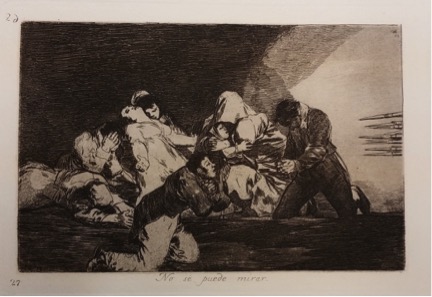Los Desastres de la Guerra

Goya, Francisco de (Spanish) (b. 1746, Fuendetodos, Spain – d. 1828, Bordeaux, France) No se puede mirar (One can’t look), plate 26 from the series “Los Desastres de la Guerra” (The Disasters of War) 1808/09-1812 (published 1863) Etching and aquatint, Sheet: 9 3/4 in. x 13 5/8 in. (24.8 cm x 34.6 cm); platemark: 5 5/8 in. x 8 1/4 in. (14.3 cm x 21 cm); image: 4 13/16 in. x 7 5/16 in. (12.2 cm x 18.6 cm) Museum purchase with funds provided by Wellesley College Friends of Art 2016.41
The Davis Museum recently acquired twenty-five prints from the first publication of Francisco de Goya’s pivotal series Los Desastres de la Guerra (Disasters of War). This purchase expanded the Davis’s holdings to thirty first edition prints, just over one third of the series. Incited and inspired by the Peninsular War between France and Spain (1808-1814), Goya created Los Desastres de la Guerra between 1810 and 1820. Los Desastres was withheld from publication until 1863, 35 years after Goya’s death. The Real Academia de San Fernando in Madrid published the first edition in a run of 500. In addition to being a seminal work in Goya’s oeuvre, Los Desastres de la Guerra is a groundbreaking depiction of the horrors of war.
In Los Desastres de la Guerra Goya upends the tradition of portraying patriotic and heroic scenes of battle and war to glorify the nation and crown. His depiction of the war focuses on the horror experienced by both soldiers and civilians. The series of 82 prints depicts the atrocities of war in three sections — images of war, scenes of the 1811–12 famine in Madrid, and the allegorical caprichos enfáticos (emphatic caprices). Goya titled each print directly and succinctly, with an inscription that reveals his repudiation of the detestable acts portrayed.